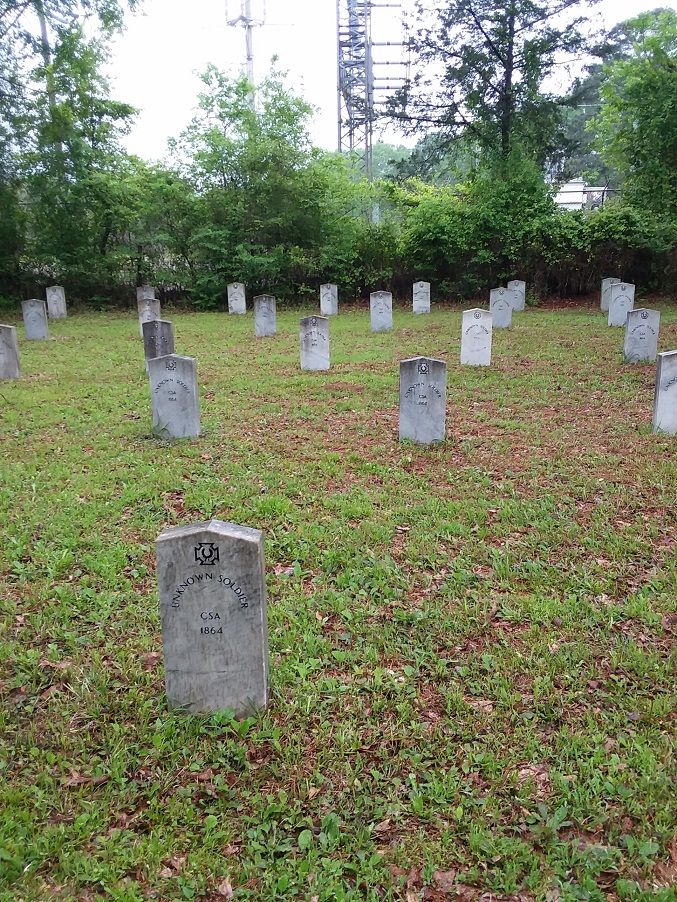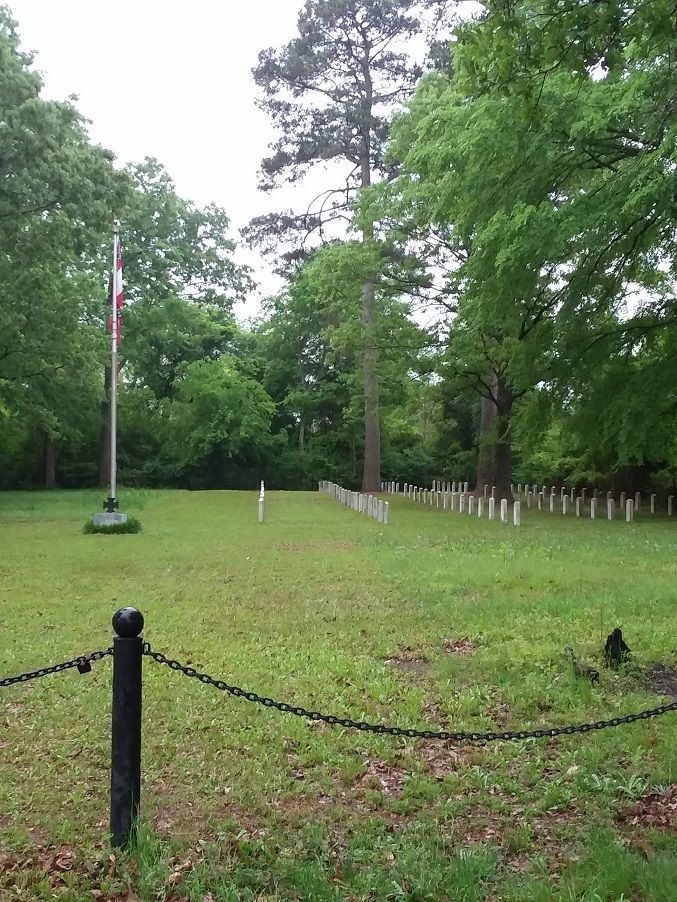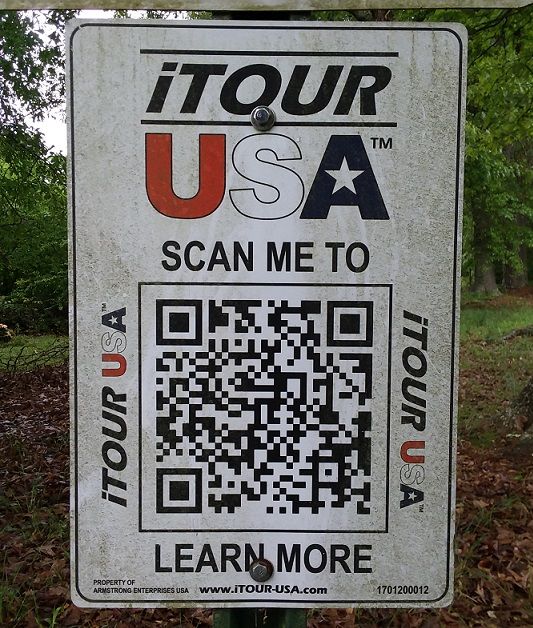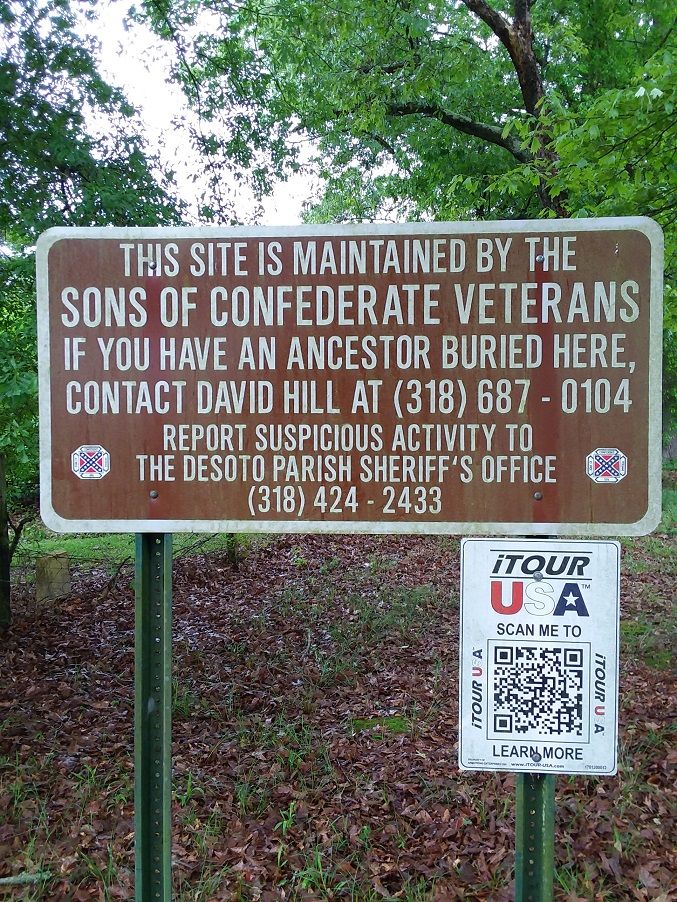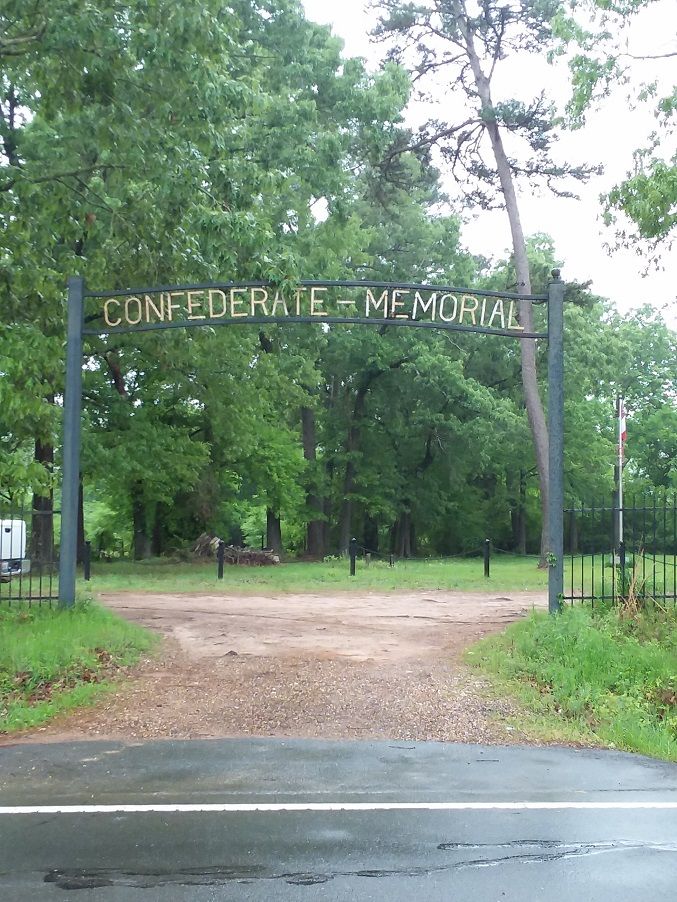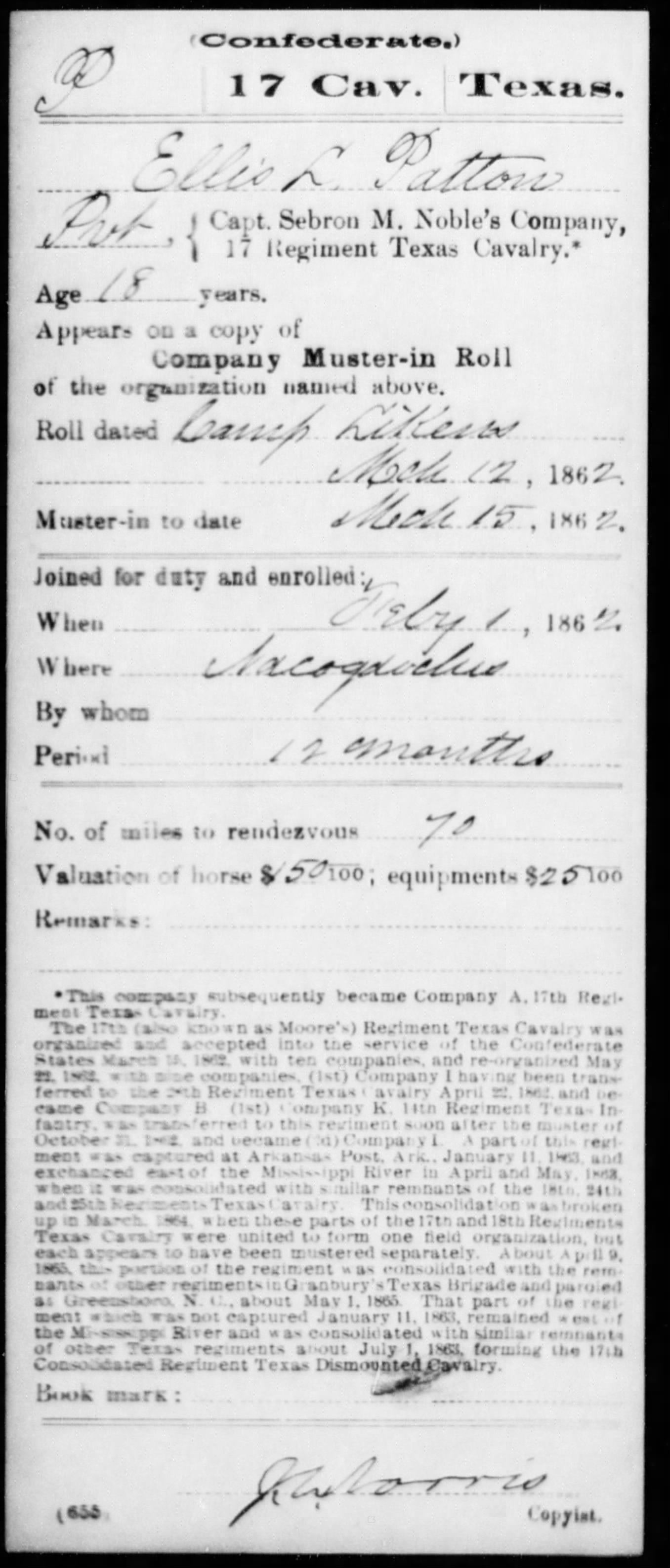Ellis participated in the Battle of Mansfield in De Soto Parrish Louisiana where he was killed.
The Battle of Mansfield, Louisiana, (8 April 1864) formed part of the Red River Campaign during the American Civil War, when Union forces were aiming to occupy the state capital Shreveport.
The Confederate commander Maj. Gen. Richard Taylor chose Mansfield as the place where he would make his stand against the advancing Union army under Nathaniel Banks. Taylor concentrated his forces at Sabine Crossroads, knowing that reinforcements were nearby. Banks prepared for a fight, though his own army was not fully assembled either. Both sides were reinforced by stages through the day. After a brief resistance, the Union Army was routed by the Confederates, consisting mainly of units from Louisiana and Texas, reportedly strengthened by hundreds of men breaking parole.
The engagement is also known as the Battle of Sabine Crossroads. At the start of the battle, Taylor had approximately 9,000 troops consisting of Brigadier General Alfred Mouton's Louisiana/Texas infantry division, Major General John G. Walker's Texas infantry division, Brigadier General Thomas Green's Texas Cavalry Division, and Colonel William Vincent's Louisiana cavalry brigade. He had also called on the 5,000 men in the divisions of Brigadier General Thomas J. Churchill and Brigadier General Mosby M. Parsons which had been encamped near Keachi, between Mansfield and Shreveport. These troops arrived late in the afternoon, after the battle had commenced.
Anecdotal evidence indicates that there were additional Louisiana men in the ranks. This included paroled soldiers from units that had surrendered at Vicksburg. Historian Gary Joiner claimed that "there may have been from several hundred to several thousand of them." The Confederate Governor of Louisiana, Henry Watkins Allen, had organized two battalions of the State Guard and brought them to Taylor's aid, yet the documentary record is unclear as to what role they played in the battle. Joseph Blessington, a soldier in Walker's Division, wrote that "The Louisiana militia, under command of Governor Allen, was held in reserve, in case of an emergency." In addition, Blessington wrote that, from the surrounding communities, "old men shouldered their muskets and came to our assistance".
During the morning, Taylor positioned Mouton’s division on the east side of the clearing. Walker’s division arrived in the afternoon and formed on Mouton's right. As Green's cavalry fell back from the advancing US forces, two brigades moved to Mouton’s flank and the third to Walker’s flank. The Arkansas division arrived around 3:30 but was sent to watch a road to the east. The Missouri division did not arrive until around 6pm, after the battle was fought.
About noon, the Union cavalry division supported by one infantry brigade of Landram's division was deployed across a small hill at the south end of the clearing. Shortly thereafter the other brigade of Landram's division arrived. Cameron's division was on its way, but would not get there until the battle had already begun.
For about two hours the two sides faced each other across the clearing as Banks waited for more of his troops to arrive and Taylor arranged his men. At that point, Taylor enjoyed a numeric advantage over Banks. At about 4 p.m., the Confederates surged forward. On the east side of the road, Mouton was killed, while several of his regimental commanders were hit as well and the charge of his division was repulsed. However, west of the road Walker's Texas division wrapped around the Union position, folding it in on itself. Ransom was wounded trying to rally his men and was carried from the field; hundreds of Union troops were captured and the rest retreated in a panic. As the first Union line collapsed, Cameron's division was arriving to form a second line but it too was pushed back by the charging Confederates, with Franklin wounded as well but remaining on the field in command. For several miles the Confederates pursued the retreating Union troops until they encountered a third line formed by Emory's division. The Confederates launched several charges on the Union line but were repulsed, while nightfall ended the battle.
The Union forces had suffered 113 killed, 581 wounded, and 1,541 captured as well as the loss of 20 cannon, 156 wagons, and a thousand horses and mules killed or captured. More than half of the Union casualties were from 4 regiments – 77th Illinois, 130th Illinois, 19th Kentucky and 48th Ohio. Most of the Union casualties occurred in the XIII Corps, while the XIX Corps lost few men.
Kirby Smith would report that Confederate loss was "about 1,000 killed and wounded" at Mansfield, but precise details of Confederate losses were not recorded. Some of the wounded, perhaps thirty, were taken to Minden for treatment. Those who died of wounds there were interred without markers in the historic Minden Cemetery. They were finally recognized with markers erected on March 25, 2008. The local town of Keachi converted its Women's College into a hospital and morgue on its second floor. 100 soldiers' remains are marked nearby in Keachi's Confederate Cemetery, maintained by the local Sons of Confederate Veterans and Daughters of the Confederacy.
Ellis participated in the Battle of Mansfield in De Soto Parrish Louisiana where he was killed.
The Battle of Mansfield, Louisiana, (8 April 1864) formed part of the Red River Campaign during the American Civil War, when Union forces were aiming to occupy the state capital Shreveport.
The Confederate commander Maj. Gen. Richard Taylor chose Mansfield as the place where he would make his stand against the advancing Union army under Nathaniel Banks. Taylor concentrated his forces at Sabine Crossroads, knowing that reinforcements were nearby. Banks prepared for a fight, though his own army was not fully assembled either. Both sides were reinforced by stages through the day. After a brief resistance, the Union Army was routed by the Confederates, consisting mainly of units from Louisiana and Texas, reportedly strengthened by hundreds of men breaking parole.
The engagement is also known as the Battle of Sabine Crossroads. At the start of the battle, Taylor had approximately 9,000 troops consisting of Brigadier General Alfred Mouton's Louisiana/Texas infantry division, Major General John G. Walker's Texas infantry division, Brigadier General Thomas Green's Texas Cavalry Division, and Colonel William Vincent's Louisiana cavalry brigade. He had also called on the 5,000 men in the divisions of Brigadier General Thomas J. Churchill and Brigadier General Mosby M. Parsons which had been encamped near Keachi, between Mansfield and Shreveport. These troops arrived late in the afternoon, after the battle had commenced.
Anecdotal evidence indicates that there were additional Louisiana men in the ranks. This included paroled soldiers from units that had surrendered at Vicksburg. Historian Gary Joiner claimed that "there may have been from several hundred to several thousand of them." The Confederate Governor of Louisiana, Henry Watkins Allen, had organized two battalions of the State Guard and brought them to Taylor's aid, yet the documentary record is unclear as to what role they played in the battle. Joseph Blessington, a soldier in Walker's Division, wrote that "The Louisiana militia, under command of Governor Allen, was held in reserve, in case of an emergency." In addition, Blessington wrote that, from the surrounding communities, "old men shouldered their muskets and came to our assistance".
During the morning, Taylor positioned Mouton’s division on the east side of the clearing. Walker’s division arrived in the afternoon and formed on Mouton's right. As Green's cavalry fell back from the advancing US forces, two brigades moved to Mouton’s flank and the third to Walker’s flank. The Arkansas division arrived around 3:30 but was sent to watch a road to the east. The Missouri division did not arrive until around 6pm, after the battle was fought.
About noon, the Union cavalry division supported by one infantry brigade of Landram's division was deployed across a small hill at the south end of the clearing. Shortly thereafter the other brigade of Landram's division arrived. Cameron's division was on its way, but would not get there until the battle had already begun.
For about two hours the two sides faced each other across the clearing as Banks waited for more of his troops to arrive and Taylor arranged his men. At that point, Taylor enjoyed a numeric advantage over Banks. At about 4 p.m., the Confederates surged forward. On the east side of the road, Mouton was killed, while several of his regimental commanders were hit as well and the charge of his division was repulsed. However, west of the road Walker's Texas division wrapped around the Union position, folding it in on itself. Ransom was wounded trying to rally his men and was carried from the field; hundreds of Union troops were captured and the rest retreated in a panic. As the first Union line collapsed, Cameron's division was arriving to form a second line but it too was pushed back by the charging Confederates, with Franklin wounded as well but remaining on the field in command. For several miles the Confederates pursued the retreating Union troops until they encountered a third line formed by Emory's division. The Confederates launched several charges on the Union line but were repulsed, while nightfall ended the battle.
The Union forces had suffered 113 killed, 581 wounded, and 1,541 captured as well as the loss of 20 cannon, 156 wagons, and a thousand horses and mules killed or captured. More than half of the Union casualties were from 4 regiments – 77th Illinois, 130th Illinois, 19th Kentucky and 48th Ohio. Most of the Union casualties occurred in the XIII Corps, while the XIX Corps lost few men.
Kirby Smith would report that Confederate loss was "about 1,000 killed and wounded" at Mansfield, but precise details of Confederate losses were not recorded. Some of the wounded, perhaps thirty, were taken to Minden for treatment. Those who died of wounds there were interred without markers in the historic Minden Cemetery. They were finally recognized with markers erected on March 25, 2008. The local town of Keachi converted its Women's College into a hospital and morgue on its second floor. 100 soldiers' remains are marked nearby in Keachi's Confederate Cemetery, maintained by the local Sons of Confederate Veterans and Daughters of the Confederacy.
Family Members
-
![]()
Henry Pace Patton
1840–1877
-
![]()
James Buford Patton
1844–1861
-
Arabella Eugenia Patton Day
1846–1865
-
![]()
Thomas Alexander Patton Sr
1848–1874
-
![]()
Cathella Philena "Lena" Patton Gilkison
1850–1874
-
![]()
William Sampson Patton
1852–1915
-
![]()
Susan Martha Patton Forsyth
1854–1931
-
![]()
Robert Lockhart Patton
1856–1858
-
![]()
Christopher Buford "Kit" Patton
1859–1930
Advertisement
Explore more
Sponsored by Ancestry
Advertisement












